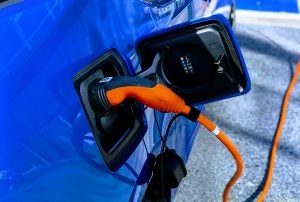Mass Appeal: How can we make electrification more affordable and equitable?
This post is the fourth in a series dedicated to the future of the electricity sector and new scholarship supported by the Alfred P. Sloan Foundation. Each post is based on a discussion between select researchers and experts working on relevant policy. To learn more and join one of our upcoming conversations, visit the series website.
Distributed energy resources (DERs)—from rooftop solar to electric vehicles (EVs)—have amazing potential to reduce greenhouse gas emissions and help us reach our climate goals. Their widespread adoption, however, could also bring unprecedented stress to an already aging electric grid. Upgrading both local and system-wide electricity grids to support this change will require thoughtful planning to minimize costs and recover these equitably.
On our recent webinar funded by the Alfred P. Sloan Foundation, the panel delved into the growing adoption of DERs, the data needed to understand trends and provide more accurate forecasting for future investment, as well as the costs—and their allocation—of upgrading our electric system to accommodate this seismic shift. Moderated by Elizabeth B. Stein, Lead Counsel for Energy Transition at Environmental Defense Fund, the panel included Dr. Jim Bushnell, Professor of Economics at the University of California, Davis; Dr. Anamika Dubey, Assistant Professor of Electrical Engineering and Computer Science at Washington State University; Dr. Alan Jenn, Assistant Professional Researcher at the Institute of Transportation Studies at the University of California, Davis; and Michelle Rosier, the Economic Analysis Supervisor for the Minnesota Public Utilities Commission.
As California goes…
California surpassed 1 million cumulative sales of plug-in EVs at the end of 2021, higher than the next 10 states combined, and has a state goal of achieving 5 million EVs on the road by 2030. It also leads the nation in distributed solar generation. California not only is an early adopter of DERs, it also provides researchers with a preview of what could happen elsewhere as the country seeks to electrify the transportation sector and take advantage of rooftop solar.
Dr. Bushnell examined the impact of EVs on energy consumption by comparing hourly load data at residences before and after the purchase of the vehicle, and notably found that “the bulk of the charging is happening during periods that are off peak.” However, once the state surpasses 6 million EVs, he sees potentially worrisome loads between 7:00 and 8:00 pm and suggests moving charging to super off peak periods to provide some relief.
He’s also not seeing any impact on the reliability of the grid. However, Dr. Bushnell suspects that utilities are making proactive investments in areas where consumers are purchasing more EVs.
Dr. Jenn is closely examining the need for investment to ensure sufficient grid capacity to accommodate EV growth. His recent project examined distribution networks in California’s PG&E territory and worked to project when EV adoption would exceed threshold capabilities of existing infrastructure. One estimate from his work suggests that over 20% of distribution feeder networks will exceed their rated capacities once 6 million EVs are on California roads.
Some utilities, especially those in California, have done a lot of work to understand where these upgrades would be needed, creating maps of future upgrades. Yet, this is a very challenging process to get right at a very local level. Dr. Jenn states that “Unlike thinking about integration of EVs at the wholesale generation level, at the distribution infrastructure level, it’s not very easy to generalize the impacts and response required to help mitigate these. There is a huge diversity of load shapes, a diversity of how close existing infrastructure already is to capacity thresholds, differences in ways people charge in different areas, and where we expect EVs to be adopted.” Not only does this make it difficult to identify non-location-specific policies that can effectively reduce system costs, it hinders the ability of utilities to accurately predict needed upgrades. In fact, Dr. Jenn and his team discovered a “huge mismatch” between the upgrades projected by PG&E’s Grid Needs Assessment and his team’s own projections – as the utility both underestimated the need for upgrades and misidentified the locations that required upgrades- underscoring a need for better modeling at a local level and the use of observed customer data.
The need for flexibility
Just as DERs are becoming more widely adopted and states are looking to upgrade their grids to reduce emissions, utilities are also managing unprecedented weather events. Dr. Dubey has explored demand-side management to increase flexibility in the grid in response to these uncertainties.
Specifically, she sees a role for demand-response contracts in increasing grid flexibility. Demand response programs pay customers for demand reductions, yet households can grow tired of reducing their demand during very hot or cold spells, or they can game the system to be paid even without reducing demand. Thus, her team developed optimal, bilateral contracts based on machine learning techniques and observed smart meter data that would reduce the financial risk to both the utility and the customer. These bilateral critical peak rebate contracts would essentially reflect the customer’s willingness to pay for demand reductions across different hours, thereby appropriately compensating them for reducing their demand at times when they otherwise would not have done so without compensation. Her research highlights how utilities can leverage customer-level smart meter data to design demand response contracts that are informed by customers’ hourly preferences and demand flexibility, thereby helping achieve broader adoption of demand response.
“If these contracts are realized… [they] can help with peak load management, provide more flexibility for the power grid and lead to a more efficient and economical grid,” she argued. “We hope these kinds of programs can help reduce price volatility from renewable energy resources by… reducing real time wholesale market uncertainty and encouraging further adoption of renewables such as solar and wind.”
The cost of data collection
States are actively working to manage this transition to the growing use of DERs. Michelle Rosier noted that the electric system in all 50 states have their own unique structure, creating a variety of responses to this challenge.
Minnesota, which is a vertically-integrated state where generation, transmission and distribution are regulated by the commission, has started to move away from planning for capacity to deal with historically high peak demands, to thinking about resource adequacy from a systems needs perspective- including hourly energy demands and other requirements, Rosier says. This shift to comprehensive, integrated resource and distribution planning is due, in part, to the need to upgrade aging infrastructure while also shifting from large generation to variable, intermittent generation and customer interest in distributed energy resources.
One of the challenges her PUC faces, she says, is the tension between modeled assumptions and real-world data for projecting capacity needs into the future, which are costly to collect. “At what point is it worth the time and the cost to collect and update real-world data vs. using assumptions, and how useful is that real-world data to an ever-changing, dynamic distribution system,” she asks, noting, “that’s a question we grapple with in nearly every docket related to distributed energy resources and the investments that our utilities are making.”
A call for more data
All the panelists noted that better data are essential to smart investments in critical upgrades. “I want people to understand the pain here,” Dr. Jenn said. “When we talk about forecasting electric vehicle adoption at the census block or census tract or county level, we’re not saying these vehicles are getting adopted at this feeder line, so there’s a huge mismatch.” Noting the difficulty of trying to allocate new EVs to specific lines, he says “It’s a very challenging process to align all of these different sectors together that are used to different mapping of resolutions and spatial work.”
Dr. Dubey noted the need for more geographically specific household-level observed consumption data for research, as our ability to effectively model human behavior is limited. She argues that data that have been anonymized or even aggregated up to a location or class could be useful without compromising confidentiality. California allows researchers access to household meter-level data, Dr. Bushnell noted, yet obtaining it has been a long process of sorting through issues like confidentiality, data security and compensation for staff time. “It’s not frictionless, but there’s now a really well-established process for researchers to gain access to data that should be something other jurisdictions could look at as incredibly valuable.”
Concerns over equity
Upgrading the grid to accommodate DERs that only a fraction of the public currently uses or can afford could exacerbate existing inequities, as those who don’t own DERs are effectively subsidizing infrastructure upgrades for those who do. Dr. Dubey argued: “We are making equity worse with our current policies,” though she acknowledged the need to subsidize these DERs in order to ensure their adoption.
Panelists agreed that creative structuring of electricity tariffs could help this issue. Dr. Jenn argued that locational pricing could help reduce cross subsidies between DER owners and non-DER owners. But given the operational (and potentially legal) challenges of conducting this type of pricing, varying connection fees or providing rebates may be a good alternative. Dr. Bushnell is exploring a type of means-tested grid connection fee that would “allow for the fixed grid costs to be pushed off of the kilowatt hour charge and on to the connection aspect.” By means-testing these rates, Dr. Bushnell believes a connection fee does not need to be regressive.
Though the path to an equitable grid is not certain, the need for one is clear, especially as demand for EVs and solar panels grows. The conversation held in this webinar demonstrated that with improved data and creative solutions, not only can the grid accommodate large amounts of DERs, but we can achieve this transition in a way that is equitable and sustainable in the long run.












